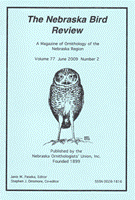Nebraska Ornithologists' Union
Date of this Version
9-2002
Document Type
Article
Citation
Nebraska Bird Review (September 2002) 70(3).
Abstract
The big news this summer was the drought which affected most of southern and western Nebraska. Conditions were particularly severe in the southern Panhandle and in the southwest. As one observer (DP) wryly noted: "The cool, cloudy weather in the sixties this morning was a welcome contrast to the stinkin' hot dirt blowing blast furnace in the low one hundreds that was in south central Nebraska Sunday afternoon [June 3]." Some comments from western Kansas by birder-rancher Scott Seltman are pertinent: "I think there's no question that because of the ongoing drought most farmers delayed their fieldwork this spring" perhaps in an unprecedented way. There are still fields in this area that will be planted to winter wheat in September [using a conventional drill] that have still not been worked even once at this very late date. So this has provided lots of ground nesting birds, like Horned Larks, an excellent opportunity to go through the entire breeding cycle without any disturbance....... I think you have to be a farmer to really appreciate the huge number of birds that attempt to nest in cropland fields every year. Sometimes they pull it off, but usually they don't."
Observations that may reflect dry conditions this summer included an absence of Mountain Plovers in the southern Panhandle (possibly a direct result of the absence of Steve Dinsmore); very low numbers of Upland Sandpipers in the southern Panhandle and southwest; a new site for Cassin's Sparrows near Wellfleet; an apparent shift of Lark Buntings northeastward away from the southwest and southern Panhandle; a decrease in numbers of Chestnut-collared Longspurs and an increase in McCown's on a BBS route in Kimball Co; and the, appearance of two Brewer's Blackbirds as far east as Valentine. Read the Species Accounts for further details.


Comments
Copyright 2002, Nebraska Ornithologists' Union. Used by permission.